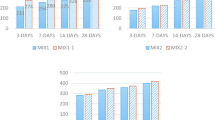Abstract
A novel crystal nucleus-based cement-hardening accelerator was evaluated using various mortar and segment concrete experiments. The mechanism of hardening acceleration was investigated via hydration temperature variation analysis, hydration degree analysis, X-ray diffraction (XRD) and scanning electron microscopy (SEM). In the presence of accelerator, the fluidity loss of mortar was increased after 30 minuites, and a coagulation was also observed. Moreover, based on the image of SEM, the formation of C-S-H gels was enhanced in the early hydration. As a result, the hardening accelerator could significantly boost the early strength of concrete, especially within one day of pouring, and shorten steam curing time to meet the demolding strength.
Similar content being viewed by others
References
Narmluk M, Nawa T. Effect of Fly Ash on the Kinetics of Portland Cement Hydration at Different Curing Temperatures[J]. Cement and Concrete Research, 2011, 41(6): 579–589
Zhang W, Wu F, Zhang Y. Early Hydration and Setting Process of Fly Ash-blended Cement Paste under Different Curing Temperatures[J]. Journal of Wuhan University of Technology-Materials Science Edition, 2020, 35 (3): 551–560
Ma Baoguo, Xu Yonghe, Dong Rongzhen. Influence of Triethanolmine on the Initial Structure Formation and Mechanical Properties of Cement[J]. Journal of Building Materials, 2006, 9 (1): 6–9(in Chinese)
Riding K, Silva D A, Scrivener K. Early Age Strength Enhancement of Blended Cement Systems by CaCl2 and Diethanol-isopropanolamine[J]. Cement and Concrete Research, 2010, 40 (6): 935–946
Jin Z, Sun W, Zhang Z, et al. Interaction Between Sulfate and Chloride Solution Attack of Concrete with and without Fly Ash[J]. Cement and Concrete Research, 2007, 37 (8): 1223–1232
Tan H, Deng X, He X, et al. Compressive Strength and Hydration Process of Wet-grinded Granulated Blast-furnace Slag Activated by Sodium Sulfate and Sodium Carbonate[J]. Cement and Concrete Composites, 2019, 97: 387–398
John E, Matschei T, Stephan D. Nucleation Seeding with Calcium Silicate Hydrate -A review[J]. Cement and Concrete Research., 2018, 113: 74–85
Alizadeh R, Raki L, Makar J M, et al. Hydration of Tricalcium Silicate in the Presence of Synthetic Calcium-silicate-hydrate[J]. Journal of Materials Chemistry, 2009, 19(42): 7937–7946
Lin K, Chang J, Lu J. Synthesis of Wollastonite Nanowires via Hydrothermal Microemulsion Methods[J]. Materials Letters, 2006, 60(24): 3007–3010
Rodriguez E T, Richardson I G, Black L, et al. Composition, Silicate Anion Structure and Morphology of Calcium Silicate Hydrates (C-S-H) Synthesised by Silica-lime Reaction and by Controlled Hydration of Tricalcium Silicate (C3S)[J]. Advances in Applied Ceramics, 2015, 114 (7): 362–371
Kanchanason V, Plank J. Role of pH on the Structure, Composition and Morphology of C-S-H-PCE Nanocomposites and Their Effect on Early Strength Development of Portland Cement[J]. Cement and Concrete Research, 2017, 102: 90–98
Li H, Xu C, Dong B, et al. Enhanced Performances of Cement and Powder Silane Based Water Proof Mortar Modified by Nucleation C-S-H Seed[J]. Construction and Building Materials, 2020, 246: 118–511
Kanchanason V, Plank J. Effectiveness of a Calcium Silicate Hydrate-polycarboxylate Ether (C-S-H-PCE) Nanocomposite on Early Strength Development of Fly Ash Cement[J]. Construction and Building Materials, 2018, 169: 20–27
Plank J, Sakai E, Miao C W, et al. Chemical Admixtures-chemistry, Applications and Their Impact on Concrete Microstructure and Durability[J]. Cement and Concrete Research, 2015, 78: 81–99
Sun J, Shi H, Qian B, et al. Effects of Synthetic C-S-H/PCE Nano-composites on Early Cement Hydration[J]. Construction and Building Materials, 2017, 140: 282–292
Thomas J J, Jennings H M, Chen J J. Influence of Nucleation Seeding on the Hydration Mechanisms of Tricalcium Silicate and Cement[J]. The Journal of Physical Chemistry C, 2009, 113: 4327–4334
Ding Q, Hu C, Feng X, et al. Effect of Curing Regime on Polymerization of C-S-H in Hardened Cement Pastes[J]. Journal of Wuhan University of Technology-Materials Science Edition, 2013, 28(4): 715–720
Author information
Authors and Affiliations
Corresponding author
Additional information
Funded by Star Program (No.1804QB1403200) from Science and Technology Commission of Shanghai Municipality
Rights and permissions
About this article
Cite this article
Deng, Z., Wang, W., Lu, G. et al. Effect of New Hardening Accelerator on the Strength of Segment Concrete. J. Wuhan Univ. Technol.-Mat. Sci. Edit. 36, 387–391 (2021). https://doi.org/10.1007/s11595-021-2421-y
Received:
Accepted:
Published:
Issue Date:
DOI: https://doi.org/10.1007/s11595-021-2421-y




